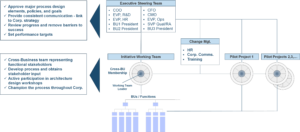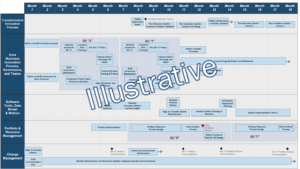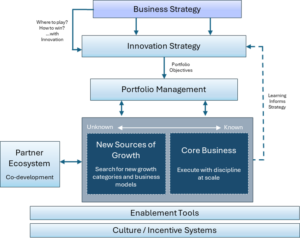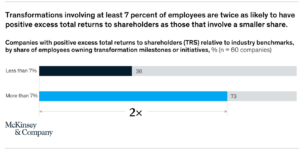For large, established companies, driving innovation is more than a strategic priority, it’s a necessity for survival in competitive and fast-changing markets. Yet, fostering innovation in a legacy organization can be a daunting task, especially when cultural inertia stands in the way. This article draws on my experiences working with global companies who have undertaken the bold initiative to transform their innovation capabilities and provides practical insights into overcoming the culture and behavior challenges that stand in the way of change.
I’ll share proven methods and tactics leaders can use to drive change. While some companies have seen significant progress in areas like employee involvement and crafting compelling cultural narratives, they have also encountered challenges in achieving consistency in leadership actions and aligning incentives. These successes and setbacks highlight the complexity of applying change management techniques in real-world settings and offer valuable lessons for senior leaders grappling with similar transformations.
To illustrate how companies have navigated these transformations, I’ll examine the key mechanisms that shape change initiatives while highlighting both successes and obstacles. By analyzing initiative governance, leadership actions, system interdependence, employee engagement strategies, rewards, symbols, and HR system alignment, I will identify the factors that drive lasting change and the barriers that hinder progress. This analysis will shed light on the practical realities of fostering a culture of continuous innovation, equipping leaders with actionable insights to guide their own transformation efforts.
Making the Case for Change
For meaningful change to occur, it is essential to first establish a shared understanding of the current state, the benefits of change, the risks of inaction, the specific capability gaps, and the precise ways the organization needs to adapt. In large, well-established companies, innovation spans multiple functions, business units, geographies, growth horizons, and management levels, each presenting its own unique challenges and perspectives. Consequently, reaching consensus on the core issues is rare and it often takes a crisis, such as declining revenue, a major product failure, the departure of critical team members, or the threat of disruption to ignite change. Successful transformations begin with a sharpened and clearly communicated “why change” narrative.
Figure 1 below illustrates how one company used a benchmark analysis to compare its current innovation performance to industry best-in-class standards across multiple dimensions. The benchmark helped identify performance gaps, highlighting the need for change and enabling the company to set realistic improvement targets. The data provided objectivity and fostered a shared understanding of the need for improvement.

Figure 1. Sample Performance Gap Analysis
Establishing Ownership & Governance
Innovation is inherently cross-functional, involving multiple management layers. But when execution issues or launch failures persist, who is responsible? The tendency is to assign blame to a specific function, often R&D or Marketing in technology-driven companies, and expect that group to diagnose and fix the problem. This siloed mindset fosters finger-pointing and defensiveness while overlooking the interconnected systems required for meaningful improvement. In reality, the necessary changes extend beyond the control of any single individual or department.
To overcome these challenges, it is essential to establish a clear governance framework that aligns responsibilities across different functions and organizational levels. In large corporations, this means differentiating between corporate, business unit, and product line levels, as each operates with distinct strategies, operational objectives, and decision-makers.
Governance for transformation is most effectively managed by a cross-functional steering team consisting of leaders from each impacted business unit and function, including R&D, marketing, operations, quality, regulatory, and finance. This team provides strategic oversight, sets performance targets, approves critical design and policy decisions, removes obstacles, and ensures consistent, enthusiastic communication. Strong endorsement from the CEO is essential to guarantee unwavering prioritization of the initiative and to secure organizational buy-in, while a dedicated cross-business working team handles day-to-day activities and champions the cultural changes needed to embed innovation practices throughout the organization.
The following graphic illustrates a sample governance structure that enables this coordinated approach. It outlines the key roles and responsibilities at various organizational levels, highlighting how leadership oversight, cross-functional collaboration, and operational execution come together to drive transformation success.

Figure 2. Sample Initiative Governance Structure
Demonstrating Leadership Action
Leaders shape employee behavior through consistent actions and messages that highlight priorities and expectations, demonstrating what they do, not what they say they do. Employees listen to what leaders say, observe their actions and where they focus their attention, recognize what they value, and use these cues to align their actions and priorities accordingly. For example, a CEO who makes time on his or her calendar to meet regularly with the initiative’s working team sends a powerful signal that the effort is a top priority for the organization.
In the most successful transformations, leadership begins by aligning on a clear change roadmap. This blueprint serves as a shared vision, mapping the path from the company’s current state to its desired future with well-defined actions, sequencing, and responsibilities. Leaders must agree on initiative goals, progress metrics, organizational changes, and time horizon. The roadmap incorporates both high impact “quick wins” and longer-term, advanced capabilities, along with the relative timing of activities and dependencies across each capability-building workstream. A well-constructed and actively maintained roadmap sets clear expectations for value realization and prevents isolated initiatives from emerging. By agreeing on this roadmap, leaders ensure that their messages, decisions, and actions remain consistent throughout the organization.

Figure 3. Sample Change Roadmap
Not all transformations maintain this level of cross-functional leadership alignment and focus. Over time, the priorities of well-intentioned leaders can shift, leading to unintended consequences. As the pressures of day-to-day operations and quarterly performance demands mount, these leaders often redirect their focus to immediate business needs, allocating resources to these areas or assigning transformation responsibilities as additional work without adjusting existing workloads. Similarly, when leadership priorities shift or the organization takes on too many initiatives simultaneously, focus on the transformation declines, and a wait-and-see approach tends to emerge.
This shift in focus has a ripple effect throughout the organization. What begins as a coordinated, integrated effort becomes piecemeal. Cross-business unit collaboration weakens, as leaders prioritize their own immediate challenges over broader, long-term goals. Pockets of resistance emerge, especially among middle managers who perceive the transformation as a threat to their authority or control. These managers openly question the legitimacy of the cross-business coalitions, making statements like, “They don’t really understand the nuances of how we operate in our business unit.” Such comments sow doubt and fracture the coalition, leaving the transformation adrift.
A transformation doesn’t fail overnight, it fades when leaders stop prioritizing it. Therefore, the CEO must act as the ultimate guardian, continuously and visibly reinforcing the business imperative, aligning leadership, and holding them accountable.
Building an Interdependent Innovation System
Companies typically start their improvement journey by making changes where there is an immediate need. This may involve implementing an improved gated-development process with Agile methods to guide core business execution or adopting design thinking and lean startup approaches to discover, incubate, and scale new business models. The results these capabilities provide can be significant, but unfortunately, they represent only a fraction of the potential value they can offer, and success is hard to sustain unless they are implemented as part of an interdependent innovation system.

Figure 4. The Innovation System
The above graphic illustrates innovation as an interconnected set of capability areas, where key elements, each with their own processes, organizational structures, governance mechanisms, workflows, and tools, function together as a cohesive system. While individual elements can be enhanced independently with significant success, the greatest value is achieved when all elements operate together. The effectiveness of any single element is ultimately reliant on the strength of the others. It takes a coordinated set of integrated initiatives that support and reinforce one another to achieve truly transformational results.
Involving Employees
Employee involvement is critical to transforming a company’s culture, fostering ownership, aligning diverse perspectives, and ensuring the adoption of new methodologies for lasting change. Employees are far more likely to embrace changes they help design, particularly in innovation process transformations.
Successful transformations prioritize employee involvement from the start. Establishing a cross-functional team with representatives from each business unit ensures a shared understanding of capability gaps and improvement opportunities. Using performance benchmarks, these teams gain insights into organizational challenges and build a collective commitment to address them.
Interactive workshops play a pivotal role giving key stakeholders the experience of being involved in shaping the future state. These sessions are designed to define guiding principles for new processes, build consensus around success metrics, and identify practical steps forward. Rather than generating extensive documentation, the focus is on creating actionable, outcome-driven processes that drive meaningful progress.
Process pilots are vital for testing and refining new approaches. Instead of lengthy design phases, pilot teams implement and validate key elements right away, demonstrating success and building momentum. Visible wins convert skeptics into advocates, creating enthusiasm and offering a clear vision of how the transformation benefits employees and the organization.
Hands-on engagement during these pilots fosters a sense of ownership as employees actively design, test, and refine new processes. This approach embeds new practices into the culture and drives the transformation forward.
However, when employee involvement is mishandled or overlooked, transformations can falter. Excluding employees from early stages, such as identifying performance gaps or defining future processes, leads to disengagement. Without a clear understanding of the reasons for change, employees may see the transformation as irrelevant or forced, leading to fear, resistance, and reversion to old habits.
How many people should be directly involved in the change effort? McKinsey & Company research, shown below, finds that involving at least 7 percent of employees as transformation initiative owners significantly increases the likelihood of outperforming sector and geographic stock indices. This 7 percent can represent hundreds of fully engaged employees, a number far above the average 2 percent involvement in most organizations.

While the number of employees involved will vary with the initiative’s scope and complexity, the principle remains clear: early, meaningful involvement drives success.
Aligning Incentive Systems
Aligned incentives, such as rewards, recognition, approval, and status, play a vital role in shaping behavior and reinforcing organizational culture. Innovation, which relies on collaboration across diverse teams, succeeds when incentives align with company, business unit, product line, and project goals.
Adjusting incentive systems in established companies is challenging, as these systems are deeply rooted in organizational culture and long-standing practices. Changes often face resistance from employees concerned about fairness or uncertainty. Balancing short-term performance goals with long-term strategic priorities adds complexity, requiring careful recalibration to prevent misaligned priorities or unintended consequences.
Effective incentive systems must align with corporate strategy. Too often, a gap exists between a company’s innovation investments and its growth ambitions. Leaders driven by quarterly targets tend to prioritize safe, short-term innovation projects, resulting in an overreliance on incremental improvements that hinder long-term growth and increase vulnerability to disruption. Successful companies link growth strategy to a balanced innovation project portfolio optimized across growth horizons.
A major challenge for companies enhancing their innovation capabilities is transitioning from siloed functional objectives to a model of team-based accountability. In this approach, team members share responsibility for product success, fostering a culture of mutual accountability. Leading organizations tackle this shift by restructuring reward systems to prioritize team performance. For example, they evaluate more than half of a team member’s performance based on peer feedback and project outcomes, ensuring that contributions to collective success are properly recognized.
However, even with the right structural changes, incentives can still fall short if they don’t resonate with employees. Many leaders unintentionally misalign rewards with what employees truly value, leading to disengagement rather than motivation. As Jennifer Chojnacki, Executive Director, Innovation & New Product Introduction at Carrier Corporation, explains, “Incentives are a tough topic. I see leaders get this wrong more often than they get it right, offering unrealistic rewards that can’t be fulfilled or misaligning incentives with what employees actually value. Too often, leaders assume their own motivations apply universally, rather than taking the time to understand what truly drives their teams.”
Financial incentives, while important, must support desired behaviors to avoid undermining transformation efforts. Misaligned rewards, such as prioritizing individual achievements over team success, can hinder collaboration and innovation. Thoughtful design ensures financial incentives complement non-financial rewards, fostering a culture where employees and teams feel both valued and motivated.
Aligning HR Systems
Aligning human resource (HR) systems with transformational change initiatives ensures that recruitment, training, rewards, and promotions support change objectives and reinforce cultural norms. Candidates are evaluated on their skills and alignment with organizational values, and employees are trained in expected behaviors. Career paths and promotions recognize those excelling in both performance and cultural fit, ensuring the organization’s values and change objectives are consistently upheld.
Successful companies also align recruitment strategies and career development to address skill gaps, enhance competencies, and teach new ways of working. Training programs are tailored to specific roles, including project team members, functional managers, and business leaders governing the innovation pipeline. Just-in-time training, meaning applied training on live projects, and role-playing exercises prove far more effective than traditional classroom methods for driving significant behavior and process changes.
To support recruitment and career progression, organizations establish clear role expectations that extend beyond standard job descriptions. These expectations define the skills, capabilities, and success criteria for roles within innovation teams, functional management, and portfolio management.
By aligning HR systems with initiative goals, organizations create a unified approach to change. This empowers employees to embrace the desired culture, building a strong foundation for sustainable innovation and long-term success.
Reinforcing Through Signals, Symbols, & Rituals
In transformational initiatives, organizations establish clear behavioral expectations to signal shared values and emphasize cultural evolution. Celebrating individuals who embody these values reinforces desired behaviors, while symbols like unique language or rituals foster belonging and alignment with the organization’s identity. These elements embed cultural messages throughout the initiative, ensuring consistent reinforcement.
Cultural alignment is strengthened by the tone and actions of senior leaders, whose influence shapes innovation teams and their approach to challenges. During project funding reviews, for instance, leaders can demonstrate trust and foster accountability through the questions they ask and the perspectives they promote. Instead of demanding, “Pull in your schedule,” they might ask, “What would it take to pull in your schedule?” This subtle shift in tone signals confidence in the team’s ability to evaluate tradeoffs and make informed recommendations. In customer-centric cultures, directives like “Start development as soon as possible” give way to “Ensure unmet customer needs are fully understood before advancing to development.” Similarly, leaders foster progress by reframing early innovation project failure as rapid learning, celebrating cost savings when unviable projects are identified and cancelled prior to full-scale development.
The use of distinctive language further encapsulates cultural values and reinforces the organization’s identity. Phrases like “customer obsession” or “bias for action” become part of daily conversations, serving as constant reminders of priorities. Successful companies also adapt leading innovation practices, such as lean startup, design thinking, and Agile, to suit their unique needs and culture. Instead of rigidly adhering to a single approach, they tailor terminology and processes to align with their organizational context.
Sustaining Momentum and Long-Term Commitment
Large, established companies often underestimate the effort required to achieve lasting success and embed it into the organization. Transforming the way a company innovates impacts every function and management level, necessitating significant cultural change. This is challenging because employees have operated within the existing culture for years. Some may perceive the initiative as a threat to their power and authority, while others may strongly resist any deviation from the status quo. Moreover, these changes must be implemented without disrupting daily operations.
Transformation is an ongoing process, not just a destination. While early results can emerge within months, providing momentum for the initiative, full internalization of the changes takes years. Successful rollout and adoption require all innovation teams and their leaders to experience the new processes and learn how to integrate them into their daily routines. The transformation unfolds gradually as success builds credibility and reinforces the new approach.
As Bridget Sheriff Bridget Sheriff, VP of Engineering at Carrier Corporation, puts it, “I learned long ago that you never get something for nothing—true transformation demands relentless effort and stamina. Lasting change isn’t achieved through sporadic bursts of energy; it’s a journey that requires persistence, resilience, and a willingness to push through resistance. People are naturally inclined to stick with what they know, so shifting mindsets and behaviors takes time, trust, and continuous reinforcement.“
Start with the fundamentals, demonstrate success, build momentum, be willing to evolve as you learn, and layer in advanced processes, techniques, and tools over time. Leaders with a short-term outlook will struggle to sustain the necessary support for this long-term effort. Moreover, inconsistent effort, fluctuating funding, and repeated starts and stops will undermine progress and lead to change fatigue.
This is why leaders must embrace transformation as a long-term commitment, prioritizing continuous improvement, fostering a culture of learning and adaptability, and celebrating each stage of value realization. By sustaining momentum and consistently reinforcing the value of change, they can prevent complacency and drive lasting success.
Conclusion
Transforming innovation processes in large, established companies is no small feat, but the rewards of a cohesive, adaptive, and innovation-driven culture are immeasurable. The experiences shared in this article illuminate the power and complexity of cultural transformation, highlighting both the potential for extraordinary progress and the pitfalls that can derail well-intentioned efforts.
The keys to successful transformation demonstrate that success lies not in isolated actions but in a carefully orchestrated, holistic approach. From the unwavering commitment of leadership to the deep engagement of employees, aligned reward systems, compelling cultural narratives, supportive HR systems, and a commitment to stay the course, every lever plays a vital role in driving sustainable change.
However, true transformation goes beyond implementing processes and frameworks; it demands a steadfast dedication to consistency, collaboration, and learning. It calls for organizations to move beyond short-term wins to foster an enduring culture of innovation that can withstand market pressures and disruptions. Leaders must be relentless in their alignment, employees must feel empowered to design and execute the change, and integration must take precedence over fragmented solutions.
As Tobi Karchmer, Chief Medical and Scientific Officer for Baxter International Inc., explains, “Transforming innovation capability isn’t just about changing processes, it requires shifting deeply ingrained mindsets. Without addressing cultural barriers, even the most well-designed initiatives will struggle to take hold and deliver meaningful impact.”
The lessons outlined here provide a roadmap for companies embarking on similar journeys. By embracing both the successes and the missteps, organizations can navigate the challenges of transformation and position themselves as innovation leaders. In the end, the path to innovation excellence may be complex, but it is a journey well worth taking for the organization, its employees, and the customers who value their breakthroughs.
References
1. Laura London, Stephanie Madner, and Dominic Skerritt, “How many people are really needed in a transformation?” McKinsey Insights, 2021
2. Daniel Coyle, The Culture Playbook: 60 Highly Effective Actions to Help Your Group Succeed, 2022
3. Charles O’Reilly, Stanford University Graduate School of Business, “How Microsoft Transformed Its Culture,” Management and Business Review, Volume 4, Issue 1, 2024
Related articles for a deeper dive on the topic
1. “Pizzas, Minivans, and the Innovation Core Team,” Mind the Product, 2018,
2. “Innovation Process Design and Software Tool Enablement,” PDMA Visions, Issue 2, 2014, Volume 38, 2014, PDMA Visions – Issue 2, 2014
3. Noel Sobelman and Tony Ulwick, “Outcome-Driven Venturing: Build the Right Solutions and Build Them Right,” The Marketing Journal, 2021 “Outcome-Driven Venturing: Build the right solutions—and build them right” – Noel Sobelman and Tony Ulwick
4. “The Journey Toward World Class Innovation: 5 Keys to Successful Implementation,” 2022, The Journey Toward World-Class Innovation: 5 Keys to Successful Implementation | LinkedIn
5. “Innovation Project Governance Do’s & Don’ts,” 2022, (1) Innovation Project Governance Do’s & Don’ts | LinkedIn
Article by channel:
Everything you need to know about Digital Transformation
The best articles, news and events direct to your inbox
Read more articles tagged: Culture






